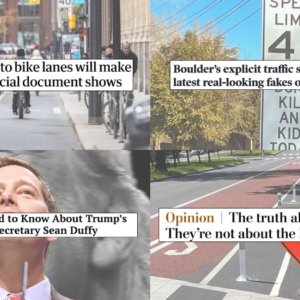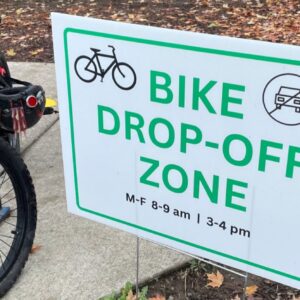Have you seen it yet? The Engineering Bingo Card video by Buff Brown that’s been making the transportation advocacy rounds this past few days? Brown is a transportation planner, engineer, bicycle advocate — and now a rapper. He’s not bad either, really! His bingo card rap is a wicked package of the most common excuses every safety advocate hears about why their [crosswalk, speed bump, sidewalk, bike lane, signal] can’t be approved. Enjoy!
OK, that’s the video, now to blow off a little steam. Many Portland transportation advocates have a folder of rejections they’ve received over the years from PBOT engineers, planners, and staff. Call them our rejection collections. We pass them around, talk about them way past their shelf life and generally obsess about them.
Here’s my tale of the rejection I can’t let go, one weird enough it doesn’t make Buff’s bingo card.

A few years back, me and my buddy noticed that the flashing school-zone light across from Ainsworth Elementary School, in Portland Heights, was poorly located. Weren’t these warning lights supposed to precede the school? So we went to work — documented the problem; found a more appropriate pole uphill on SW Vista; wrote a 3-page PDF describing the situation and solution; sent it off to PBOT … and waited, and waited, and waited.
Finally after three months, I got hold of the traffic investigator assigned to us and got my rejection. The reason? The pole where we wanted to relocate the flashing light was uphill from the school, at an elevation above the grade of the school-yard, which disqualified it as a location. (Streets on hills are like that.)
Ba-da-boom.
Yeah, it’s a head-scratcher. I ruminate on it in my idle moments. All I’ve been able to come up with is a situation where a school was bounded by a road at a different elevation from the local roads, such that the elevated road didn’t intersect locally. But that’s not the case with Ainsworth or its annex. You get to both by Vista. Anyone with a lick of sense could see that one of its two flashing lights needed to be placed on the approach from the south.
It all worked out in the end. After a years-long hiatus due to exasperation, I was coaxed into picking up the project again. The Safe Routes to School people came in and did a lot of traffic calming, they were wonderful. A new vice-principal with a fire-in-her-belly about safety became an ally. And now, young children can walk to school a little more safely because the flashing beacon alerting drivers to their presence is appropriately placed at the approach to the school, not directly across the street from it.
But it took five years, a few experienced advocates, two rejections by engineer-types, and a motivated vice-principal to make it happen. At least that’s how I remember it.
What’s your story?







Thanks for reading.
BikePortland has served this community with independent community journalism since 2005. We rely on subscriptions from readers like you to survive. Your financial support is vital in keeping this valuable resource alive and well.
Please subscribe today to strengthen and expand our work.
Lovely video, sent it on to all my engineering friends, both of them.
There’s also the common excuse: We’ll get it done soon! It’s in the TSP! (i.e., we’ll never fund it…, and if it does actually get funded, we’ll keep delaying it until inflation eats up all the value so that only part of the project gets built, that part that car drivers benefit from.)
Lisa is being modest. It took 10 years, and the reason SRTS was able to step in and do job was that she and her allies wrote up a point-by-point refutation of the engineer’s reasons for denial, with pictures and state code. Her husband has stood in a busy street helping measure shoulder widths. She surprised city council meetings with data collected by herself and volunteers, from statistics to demographics to traffic counts. She and her allies got much work done by dragging city employees to the spot and pointing out details not obvious on Google images (including infamously making an employee walk in a road like we all had to, with the staffer muttering ‘shit this is dangerous’ under their breath the whole time).
See that bingo card? Ever hear the Margaret Meade quote about change? This is a bit tangent from what Lisa wants you folks to post, but the way to beat the bingomaster is groundwork, groundwork, groundwork. Know the codes as best you can, anticipate the excuses, and document anuthing and everything that potentially refutes it. Staff contempt for citizen advocacy can be pretty ripe, and if you are not a paid consultant they will insist your numbers are wrong, or that you just don’t understand. Staff can also surprise you, and agree… admittedly, they sometimes agree but can’t do anything, but hey, take it as a win!
Lisa’s allies have had big wins AND big losses through all this, but the point is they tried. They’ve learned lots, and might do things differently now. That’s part of what a bureacracy expects: you are learning a game they have mastered, and you might give up and go away after a while. For all of its sins, Capitol Highway was done largely because Maryanne Fitzgerald and her allies wouldn’t give up.
So please post wins, losses and just plain puzzlers here as Lisa asked. New eyes might yield a solution. And remember, if it has been three years since the last request to https://www.portland.gov/transportation/823-safe you can resubmit it for a new evaluation.
Or live in a different part of town. When I lived in Goose Hollow and later in Sullivan’s Gulch, it was pretty much impossible to get stuff funded and implemented. Then I moved to Hazelwood in East Portland in 2008 and suddenly it became really easy to get stuff funded and implemented – working with other community leaders we got over $400 Million of stuff funded, some of which was built almost immediately and some is still being built 16 years later, but it was relatively “easy” because we had the demographic numbers in our favor – density, ethnic minorities, youth, poverty, BIPOC, high-crash intersections, you name it – and we would furnish ranked project lists directly to the city engineers (skipping the useless city planners) who would then find federal and state grants to pay for them. It helped that then-mayor Sam Adams was so gung-ho on fixing East Portland and Cully at that time (2009-12) and that subsequent politicians have tripped over themselves in getting stuff funded, even the governor got us $104 million to finish outer Powell. Yeah, PBOT itself is still glacially slow in actually building what they are supposed to, it took them over 10 years to do the very simple and basic 130s and 4M bikeways, but ODOT and TriMet have been quite quick about it, relatively speaking.
Hi Lisa – Thanks for putting up my video. FYI, I was the Transportation Planner for Tigard for 3 years (2015-2018). I can’t tell you how much pushback I got from one of the engineers at Tigard (now gone) during that time. He was a champion of excuses, while also going to conferences claiming the incredibly great things Tigard was doing for bike/ped infrastructure. Ugh. I have a few well-researched Portland-focused blogs on http://www.transportationjusticeblog.com. I will be retiring back to Portland in the next few years. See you soon.
I’m star-struck! Thank you for commenting, and I look forward to your return (to southwest I hope, we need a lot of help).
After a brief purusing transport justice blog, it seems we’re on similar paths. I celebrated voter rejection of the SW Corridor MAX extension to Tigard and make a comparison between it and the RoseQ I-5 so-called “improvement” similarly fraught with unacceptable traffic hazards, criminally prosecutable hazards inherent in their design.